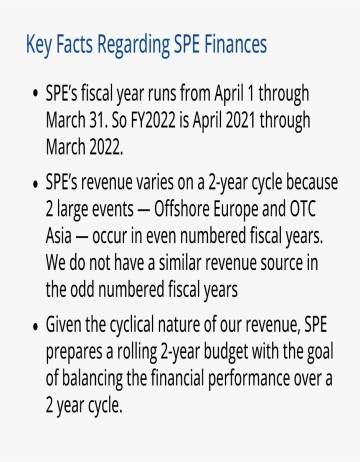There’s no denying that SPE has been through some rather challenging financial times in the past 10 years. Our 2014 fiscal year, which ended 31 March 2014, was SPE’s peak revenue year at just over $84 million. Oil prices at the end of that fiscal year were over $100/bbl. Prices began falling during the second half of 2014, reaching around $50/bbl at the end of FY2015. Prices continued to fall, accompanied by significant industry cuts in staffing and spending, reaching the $30/bbl range by the end of FY2016. Prices began recovering into FY2017, but not rapidly. Companies remained cautious in their hiring and spending, causing the pace of recovery in SPE’s business to lag the increase in oil prices. But the trajectory was upward.

During these challenging years, when the industry mantra was “lower for longer,” SPE made the very difficult decision to reduce our staff complement by about one-third. This was done through voluntary and involuntary workforce reductions, which occurred in fall of 2015 and fall of 2016. We recognized that industry activity was likely to remain constrained for several years and restructured accordingly. We tried to limit cuts to our programs despite this staff reduction, recognizing that when the industry is down is when many members need SPE the most. Our healthy reserve fund, built up during better times, was used to sustain SPE's member programs during this difficult period.
For the following 2 years and 10 months, we saw the benefits of this approach as we rebuilt our financial strength before the pandemic changed conditions. In FY2018, SPE had a positive operating income of $1.8 million, about what we would expect in a year that includes both Offshore Europe and OTC Asia. FY2019 did not include those two major events and had an operating loss of $835,000. Over the 2-year cycle of FY2018/2019, SPE had a net surplus of $937,000. FY2020 was on track to achieve a $2.1 million operating income until the global pandemic lockdowns. We were unable to hold 15 events scheduled during February and March 2020, resulting in a loss of $2.5 million in income, leaving us with a net loss of $443,000.
As an organization that receives the largest share of its revenue from in-person events, the pandemic affected SPE significantly. During FY2021, we were unable to hold any in-person events — everything was virtual. While some members found the virtual format beneficial, many preferred to wait until they could meet with colleagues in person. We are proud of our ability to make this pivot and continue to offer valuable programming to our members during times of lockdown and no travel.
We started FY2022 with guarded optimism that we could begin scheduling in-person events again, holding the first one successfully in May of 2021. But the global surge of the Delta Covid-19 variant during the following months caused many events to be postponed again or severely scaled back. We created a Virtual Programs group to help us broaden access to the virtual content that was created. This team launched the very popular SPE Live programming that is ongoing. In January 2022, they also launched Energy Stream — a platform to bring together all our virtual content. We’ve added sponsored Tech Talks as well, with positive reactions from both attendees and sponsors. We hope to see revenue from this new platform grow over the next year.
In FY2023, in-person events are back and being well attended. Corporate support for events through sponsorship and exhibition remains lower, however. Overall, our event revenue is budgeted to be at 60–80% of prepandemic levels.
How Did SPE Survive the Pandemic?
Leadership considered all our options, including staff reductions, and decided to continue delivering a high level of service to our members (with only minor program reductions). Both the US and Canadian governments had programs for employers to subsidize keeping staff on the payroll. These programs didn’t cover the full cost of retaining staff, but these funds made a significant difference to our budget. The booming stock market during 2020 and 2021 replaced most of the money that we took out of our reserves to continue providing services. SPE’s staff complement was reduced by 11% during the pandemic, mostly through attrition. Our remaining staff accepted salary cuts during the first year of the pandemic. They worked harder and acquired new skills, and we were able to retain the wide range of programs we offered before the pandemic.
Retaining staff has been the right decision and why we are on track for 75–80% of prepandemic revenue this year. Having experienced staff has enabled us to accommodate pandemic-related changes and bring members back to the in-person experience that they expect. We anticipate that FY2024, which includes Offshore Europe and OTC Asia, will move us closer to prepandemic levels of revenue, while producing a small positive operating income ($200,000).


